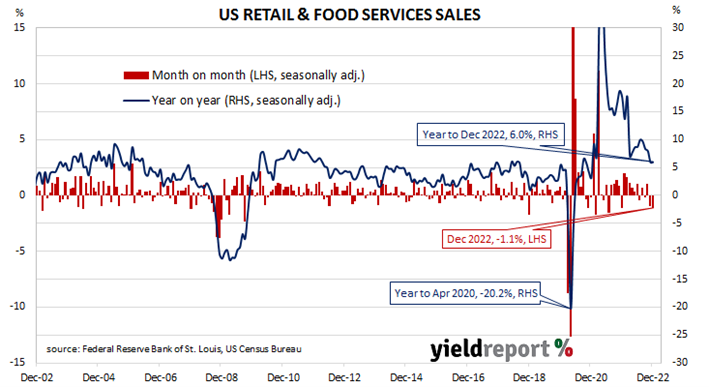Summary: US retail sales up 1.3% in October, greater than expected; annual growth rate slows from 8.6% to 8.3%; figures “point to still-strong consumer demand”; short-term Treasury bond yields up, longer term yields down; rate rise expectations firm slightly; rises in nine of thirteen retail categories; gas station segment largest single influence on month’s result.
US retail sales had been trending up since late 2015 but, commencing in late 2018, a series of weak or negative monthly results led to a drop-off in the annual growth rate below 2.0%. Growth rates then increased in trend terms through 2019 and into early 2020 until pandemic restrictions sent it into negative territory. A “v-shaped” recovery then took place which was followed by some short-term spikes as federal stimulus payments hit US households in the first and second quarters of 2021.
According to the latest “advance” numbers released by the US Census Bureau, total retail sales decreased by 1.1% in December. The result was less than the 0.8% decrease which had been generally expected and slightly less than November’s -1.0%. On an annual basis, the growth rate remained unchanged at 6.0%.
“The weakness may have been exaggerated by the heavy snowstorms late last month, but the trend towards weakness is clear. November sales were also revised down,” said ANZ economist Madeline Dunk.
The figures came out the same morning as the latest industrial production numbers and industrial production figures. US Treasury bond yields fell noticeably on the day and, by the close of business, the 2-year Treasury yield had lost 12bps to 4.09%, the 10-year yield had shed 18bps to 3.37% while the 30-year yield finished 12bps lower at 3.54%.
In terms of US Fed policy, expectations of higher federal funds rates over the next 12 months softened. At the close of business, contracts implied the effective federal funds rate would average 4.59% in February, 26bps higher than the current spot rate, and then climb to an average of 4.655% in March. May futures contracts implied a 4.855% average effective federal funds rate while December contracts implied 4.425%.
“The Fed will be pleased to see demand for goods normalising towards its pre-pandemic trend, potential weather distortions aside,“ Dunk added.
Ten of the thirteen categories recorded lower sales over the month. The “Gasoline stations” segment again provided the largest single influence on the overall result, falling by 4.6% over the month and contributing around -0.40 percentage points.
The non-store segment includes vending machine sales, door-to-door sales and mail-order sales but nowadays this segment has become dominated by online sales. It now accounts for 16% of all US retail sales and it is the second-largest segment after vehicles and parts.



